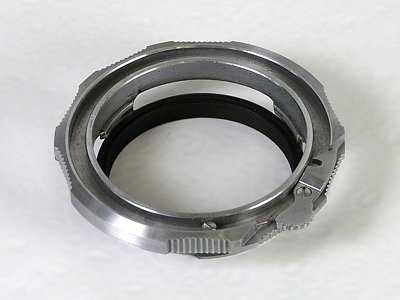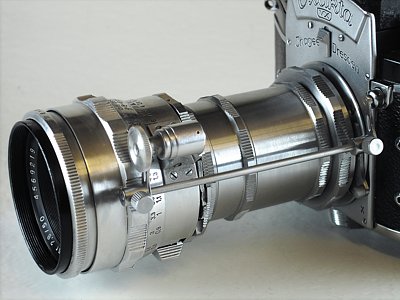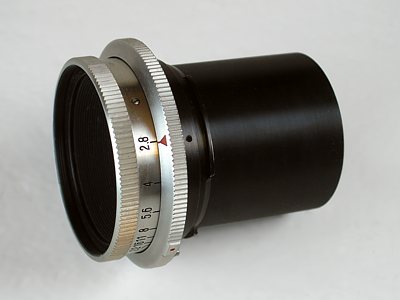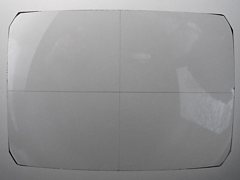Traditionally, in the realm of 35-mm cameras one says macrophotography when the image size on film is 1/2 or more of the actual object size. The 1:1 scale requires the lens to be moved away by an extra focal length from the film plane. Thus, a 50 mm lens will require an extra 50 mm extension to provide life-size image on film. Larger extensions allow for greater-than-life scale ratios.
In addition to special lenses providing extra-long focusing helicoids (like the famous 2.8/35 mm Macro Flektogon), there existed a large variety of macro accessories for the Exakta/Exa system.
Extension rings
This was the least expensive way to get into close-up and macrophotography with an Exakta. The rings were sold in sets, consisting of the rear bayonet ring (attached to the camera, and with a threaded front), a set of (usually three) double-threaded tubuses of various lengths, and then a front bayonet ring with the thread in the back. These can be seen in the picture, from bottom to top.
There were also aftermarket extension rings made by various manufacturers. One such set (origin unknown) is included in the picture.
-r.jpg)
The shortest extension possible with such a set was 10 mm (when just the front and rear bayonet rings were used, with no tubes in-between). This would result in magnification of 0.2 with a 50 mm lens. The tubes provided an extra 5, 15, and 30 mm, or any combination of these, so that the maximum extension possible was 60 mm, resulting in magnification of 1.2 (slightly more than life size).
For some close-up applications the 0.2 magnification would be too much. Therefore there was an extra accessory available (usually sold separately): a double-bayonet ring, with just 5 mm of extension, and magnifications from 0.1 (more if the lens itself was set to less than infinity).

Extension Release
A semi-automatic or automatic lens used on extension rings or bellows no longer couples with the shutter release on the camera. This is why Ihagee offered a contraption called Auslösebrücke, or release extension.
Two versions were made:
- A shorter one (1956), with the rod length of 9 cm, long enough for extension tubes; this is the one shown in the picture.
- A longer one (1961), with a 15 cm rod in addition to the previous one, making it usable with the Ihagee macro bellows.

Greater and continuously adjustable extensions were possible with macro bellows.
Ihagee made one model of these (in a number of cosmetic variants), providing extension from 35 to 125 mm. The unit had bayonet mounts on both ends, so it would work with any Exakta-compatible lenses.
It is shown here, mounted on a Varex IIa (*5.1.1.e), with a sunken-mount 2.8/50 Tessar and magnifying finder with loupe. These will be separately described below.
To see how I am using these bellows on a digital camera, click here.
-iha-bel-r.jpg)
A number of other manufacturers offered macro bellows for Exakta. Some were more flexible or longer (e.g., Novoflex), some — just less expensive.
Shown here are the Kopil bellows, mounted on a Varex IIb (*6.0.e) with a Westrocolor 1.9/50 lens. A double cable release (made by Pentacon?) is used to retain aperture coupling.
The setup also uses the magnifying finder, but this time with a 2.0/50 manual Biotar lens serving as a loupe.
(The Kopil bellows are easy to find even now: I bought these on eBay for just $5.)
-kopil-bel-r.jpg)
Bellows lenses
The minimum lens extension of 35 mm available with the Ihagee bellows would limit the maximum focusing distance or minimum magnification. For a regular 50 mm lens only magnifications above 0.7 would be possible, necessitating switching to and from extension rings in many typical applications.
The best known example of a bellows lens is the 2.8/50 Zeiss Tessar (shown). It can be also seen in the first picture of the Macro Bellows section above.

Finder magnifier unit and loupe
To help in critical focusing in macro applications, a special interchangeable finder was made.
It would accept any finder screen (of these fitting prism finders), and provide a regular Exakta lens bayonet on the top. A short-to normal (35-50 mm) lens mounted there could serve as a high-quality magnifier.
(Click at the picture to see the full-screen version, where the differences will become instantly obvious.)
I also have the later version without any markings on the chromed metal plate.
-r.jpg)
Lenses were quite expensive and not every user had one to spare, therefore a separate loupe magnifier was made to work with the unit.
As in the previous case, two versions of this loupe were made. The older one (at the right) was more squat and had the eyepiece of 23 mm in diameter, compared to 18 mm in the newer version (where it was also protruding a bit).
-r.jpg)
Focusing screens
Adding any extension to the lens-film distance greatly reduces the brightness of the image — both on film and in the finder. For example, when using all extension rings to get a 1:1 magnification, the image gets four times less light (i.e., two F-stops). Using the macro bellows at full extension makes virtually impossible to see anything in the finder.

